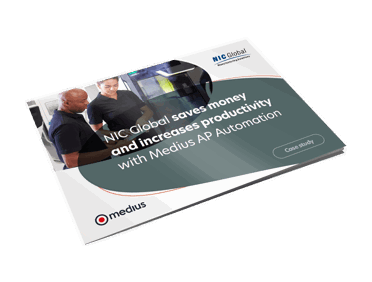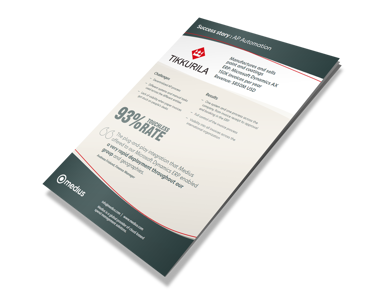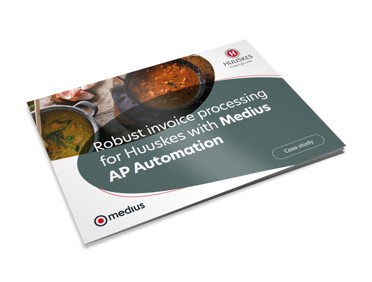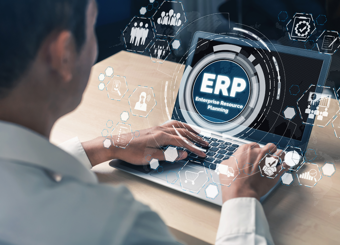

Overview
Accounts payable automation (AP automation) refers to the utilization of software tools to streamline and enhance routine vendor invoice activities. This leads to safer, more efficient, and cost-effective AP operations. Typically, AP automation facilitates digital document handling, invoice management, purchase order alignment, and payment matching. Accounts payable automation helps businesses manage spend and obtain insights to make smarter decisions.
Accounts payable automation allows companies to process supplier invoices without manual intervention, offering a digital workflow to manage steps traditionally overseen by an AP staff member.
Holistic accounts payable automation enables automated start-to-finish business payment processing. This starts with software that captures invoice data in a digital format, usually through a form of scanning or capture method, such as optical character recognition (OCR). The AP system then classifies, matches, and validates data, and forwards to the accounting system or ERP to be processed.
Accounts payable automation can provide significant cost savings for a company beyond the expected savings from eliminating manual tasks. Companies can optimize their vendor portfolio, avoid duplicate or erroneous payments, reduce fraud risk, and take advantage of early payment discounts.

The problem with paper
Reducing paper saves money, time, and the environment.
Imagine coming into work to find a desk stacked feet high with paper or to a printer putting out piles of checks waiting to be signed and mailed. It's enough to make you want to quit on the spot — but it's a sight we see more often than not.
Figuring out where to start sometimes seems impossible. It overwhelms staff and is prone to error. Instead of spending precious brain-power trying to make a dent in the never-ending influx of paper — proactively eliminate it from the equation through accounts payable automation.
Disparate systems
If you've ever worked a job that required moving back and forth between multiple systems — you already know why this is a friction point.
An AP professional may have to pull or input information into these systems in a single day:
- Excel
- ERPs
- Banking systems
- Internal systems
- OCR or scanning systems
This practice creates an opportunity for mistakes that doesn't have to exist. All it takes is one typo in an excel sheet that is then entered into other systems to cause a domino effect of mistakes that will eat up time and burn through money to fix.
On top of that, finance departments could save 40% or more on costs by eliminating time-consuming manual report building and tracking.

How AP Automation works
Contrary to popular belief, implementing AP automation is not a process that takes years.
"Automation is too expensive, and it takes too long to get running," is a common response we get from organizations looking to advance their AP processes. In truth, automating accounts payable and enabling electronic payments with the right platform has a low entry point, high returns, and a quick turnaround.
Not sure if your accounts payable process is already automated? Check out our recent blog post on this topic to confirm one way or the other.
Spoiler Alert: most departments are already partially — but not fully — automated.
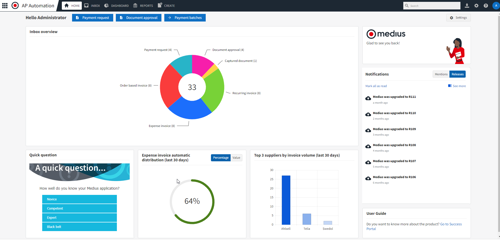
Is your invoice processing workflow full of manual tasks such as sorting, categorizing, and entering invoice data?
This is true for a wide swath of U.S. finance departments. Ardent Partners finds that 48.1% of all invoices are still manual and not processed electronically. If you have a convoluted payment process, odds are, somewhere in it is too much paper.
If your invoices are still paper-based, this is a prime area to introduce automation and electronic invoices. Invoice automation simplifies your otherwise convoluted payment process. Check out this blog post to find out how.
Best thing about invoice automation in today's age? It enables remote approval! As the modern workforce becomes
more mobile, it's essential to have a process that allows invoices to be processed from anywhere your staff may be.
The benefits don't end there, it also:
- Approve invoices on the go
- Comment online to note any discrepancies
- Complete audit trail of approvals or actions
Paper-based processes have left many organizations at a disadvantage for years. U.S. businesses are behind our European counterparts in this regard. Electronic payments are prevalent in our personal lives — and almost entirely lacking in our B2B payments.
Payment automation empowers AP departments to issue electronic payments remotely and more efficiently. Plus, it makes real-time tracking easy and gives you 24/7 access to payment information.
Externalities, such as email phishing attacks and spoof events, are inherently unpredictable, becoming more common, and out of our control. But we can control how we react to them.
Having the ability to adapt quickly is essential in today's world, and AP automation is an critical tool for finance departments looking to prepare for the unknown.
Do you like your current ERP? Most people do (at least to some extent)! ERPs are expansive and useful tools for businesses.
They make it easy to handle tasks that include business support, supply chain planning, supply chain execution and merchandising. It may even have a way to manage invoices and payments — usually as an extension you can purchase and add on to your current process.
That being said, your ERP isn't the best choice for automating your current payable processes. To go even further, it isn't the best choice on its own.
The right invoice and payment automation solution will integrate and work with your ERP — ensuring you get the transparency and transaction security from a proper payments platform without losing the ERP tools you like and are familiar with. ERP integration also enables remote AP solutions.
We can integrate with your ERP in a matter of weeks. We partner with well-known ERP's like the ones listed below:
- Microsoft Dynamics ERPs including: Microsoft Dynamics 365 F&SCM/F&O, Microsoft Dynamics 365 AX, Microsoft Dynamics NAV
- SAP S/4 Hana
- Infor M3
- JD Edwards
- Netsuite
AP automation comes with sweeping changes, and they differ for each role involved in the accounts payable process.
How does Accounts Payable
Automation benefit businesses?
- Provides improved visibility into spend
- Improves cash flow management
- Reduces risk of fraud
- Enhances control over how suppliers are paid
Want to find out how much your company could save with an AP Automation Solution? Try our Savings Calculator. Enter a few figures into our tool to see your potential savings. Compare your metrics against the average Medius customer to see how much you can save. Enter your data for immediate results, or download a custom report.


How does Accounts Payable Automation benefit departments?
Automated accounts payable systems help make AP departments successful by streamlining invoice processing. It enables:
- Efficient, accurate, and timely invoice processing.
- Improved time management, allowing AP Managers to spend less time on manual tasks and more time on work that adds strategic value to their business.
- Enables full visibility of invoices, spend and cash flow management to ensure AP teams can close the books on time, every time.
For a more in-depth look at the full range of benefits that AP automation technology provides, see our 10 Key Benefits of AP Automation blog.
Automation impact by role
The human side of accounts payable (AP) automation.
Accounts Payable Managers

Accounts payable management covers the day-to-day operations of accounts payable — they're the subject matter experts on how the department ticks and succeeds.
At its core, AP automation is a type of digital transformation. It's a technological tool that allows AP managers to become even better at what they're already great at.
Transforming accounts payable processing with automation gives staff:
- Better visibility and insight into invoices and payments
- Access to your invoice and payment information anytime, anywhere
- Reduced need to field status update requests from vendors
- No more duplicate payments or bounced payments
- New capabilities and tools that require less manual work
- An easy to use system that gets smarter with every invoice
- Visibility into bottlenecks so you can get ahead of problems
- Peace of mind so you can go home on time and rest easy
IT Manager/CIO

Completely cloud-based and automated accounts payable frees IT personnel from dedicating their time and resources to AP upgrades and security risks. AP automation technology not only gives you more control over your department — it increases security at the same time.
Automated accounts payables equals:
- Reduced cost of IT overhead
- Reduced risk of fraud
- Out of the box reports for unrivaled visibility Security is an increasingly prevalent issue, especially when paying vendors.
This is another area that AP automation can advance. It creates a positive relationship between you and your vendors, which in return, allows you to work together rather than against each other. This makes increasing security to protect your interests — and theirs — a much smoother process.
Medius is designed and built for Microsoft Azure to provide our customers with the security, scalability and business continuity offered by the Microsoft infrastructure. In addition to security compliance and certifications provided by Microsoft Azure, Medius maintains SOC 1 Type 2 and SOC 2 Type 2 compliance, relating specifically to data security of the Medius platform.
CFO/Controller

At a high-level, CFOs are responsible for managing accounts payable strategy and goals, while Controllers focus on the connections between AP and the rest of the company. For both, it is essential to ensure that AP helps rather than hinders their company's growth and well-being.
AP payment automation = 100% control by enabling:
- Complete visibility into ongoing and past payments
- Anomaly detection to alert you to risks like duplicate payments or potential fraud
- New revenue streams by converting to virtual cards
- Separate approval and payment responsibilities by user/role
All of this is possible with a payables system that makes real-time business intelligence analysis easy. Accounts payable automation technology enables reporting and tracking from anywhere you have a laptop, tablet, and or mobile device.
Our AP solution allows you to track payments by type, payee, or vendor. Gain complete visibility into your accounts payable department.
Electronic payments and platforms make life easier for everyone involved in accounts payable. There are a variety of digital payment options out there, and they all have their own pros and cons. Keep reading to get details on what's out there!
Digital payment options
There are many payment methods for AP out there. Enough that choosing what to use can be a challenge.
It’s no surprise that B2B eCommerce is rapidly growing. It's essential for companies to have a payment method and process in place to meet the increased demand on the horizon.
Ease and cost-effectiveness are often behind which payment method a company ultimately chooses as their primary B2B payment option. Here we'll briefly go over the different digital and no-touch payment options.
ACH & Same-Day ACH
Over the years, automated clearing house (ACH) has managed to remain one of the top five most common B2B payment methods in North America. But with the rising movement to reduce costs — while simultaneously increasing security and streamlining cash-flow — forward-thinking companies are moving towards new technology and payment methods.
Regular ACH is a direct and electronic payment that isn't immediate. It can take anywhere between three and five days to process. It's essentially a check in digital form.
It has all the benefits and ease of paper checks without creating piles of paper to bog down your AP staff. Buyers like it because of how convenient it is and sellers like it because they get access to funds quicker when they don't have to wait on a paper check to arrive in the mail.
Even better, with same-day ACH sellers will receive their payment within one business day.
What is same-day ACH, you may ask? It's a newer and more immediate form of ACH. It will allow payment posting on the same business day if initiated before 2:45 PM. Studies show that same-day ACH is rising in volume with a 42% increase in Q1 2020 compared to Q1 2019.
The ability to make ACH payments recurring and automatic is their strongest selling point. It saves time, reduces paper, and ensures bills are paid on time. It also comes with a loss of control, less privacy, and the potential for automated payments that aren't monitored to overdraw or overpay a charge.
Real-Time Payments
Real-time payments (RTP) are one of the newer payment methods. It combines:
- Immediate fund availability
- Settlement finality
- Instant confirmation
- Integrated information flows
In terms of cost, real-time payments cost the same as other non-instant electronic payments and significantly less than traditional methods like paper checks.
However, it's important to be aware that RTP has risks. It is at a heightened risk for fraud and transactions can't be halted once finalized.
A real-time payment transaction is completed in less than five seconds, which removes any window to cancel a wrongly authorized payment. Virtual Cards
Last, but certainly not least, is virtual cards. V-cards are a B2B payment method that is rising in popularity. Approximately 26% of companies are planning to incorporate virtual cards into their payments strategy within the next year. We expect this number to go up as more companies invest in no-touch payment methods.
A virtual card is a 16-digit unique card number that is created to be single use. In practice, it is a virtual credit card that is designated for paying your vendors.
Swapping out paper-burdened payment methods with one that uses virtual cards will streamline AP processes, give you the ability to earn cash rebates, increase security, and enhance internal controls.
Keep reading for a deeper dive on the benefits that come from using virtual cards and debunk the myths going around about them.
Wire Transfers
We can't talk about digital payment methods for AP without talking about the second most-preferred option for B2B in North America — wire transfers.
It also comes in second for incidence of fraud.
In a modern environment that includes increased remote working, this vulnerability to fraud has serious implications. Wire transfers are at a greater risk when authentication and network security are more lax.
Wire transfers also cost more because their use comes with greater bank chargers than methods like ACH. For this reason, wire transfers are predominantly used by larger firms that make and receive international transactions.
Purchase Cards/Company Cards
Purchasing cards (P-Cards) are a form of company card that enables goods and services to be procured without using antiquated purchasing methods such as paper checks.
They are issued to employees who are trusted to follow the guidelines you set for using the card. A variety of controls can be put on these cards, such as:
- Single-purchase dollar limits
- Monthly purchase limits
- Restrictions to specific merchant category codes (MCC)
- Monthly reviews and approvals of purchases by someone other than the cardholder
The major drawback to using purchase cards is that they're one of the least secure options — exposing companies to credit card fraud and identity theft.
Purchase cards are often confused with virtual cards (V-Cards). Check out this blog post to find out when to use one over the other.
Perks of virtual cards for AP
Create a new revenue stream via rebates.
The opportunity for new revenue is perhaps what entices companies to try virtual cards (v-cards) the most. The ability to earn monthly rebates is a game-changer. It's the difference between a department that operates at a loss and one that is earning money for your company.
Virtual cards can generate upwards of 1% cashback on AP spend. It's an immediate return on investment (ROI) on any transaction with a vendor that is done via v-card.
Still skeptical? Use our Savings Calculator to find out how much you stand to save.
Don't miss out on the chance to be the finance hero your AP team is looking for! Virtual cards make it possible to earn extra revenue, extra cash, in the course of your regular duties.
For every dollar of virtual card payments, you have the potential to earn a cash rebate when you select the right program. The more virtual credit card transactions, the more you earn back.
Leveraging virtual cards instead of outdated paper checks goes a long way towards streamlining your accounts payable process. The ability to remove manual processes makes the entire thing more efficient by default.
This allows accounts payable departments to focus less on processing payments and more on essential financial responsibilities. Relieve them of tasks such as:
- Writing checks
- Stuffing checks in envelopes
- Metering envelopes
It also eliminates the opportunity for human error by decreasing the amount of times a person is involved in a step of the payment process. Another aspect that protects against mistakes and fraud is that virtual cards are designed to be for one time use.

Virtual cards are a B2B payment type that is rising in popularity both because of the ease of their use and how much more secure they are than antiquated methods. A v-card is a virtual credit card, complete with a unique 16-digit card number.
They are designed to be used for paying vendors and come with heightened security standards, transparency for your staff, and easy processing. Virtual cards are designed to be single-use between a payer and a payee — and as the payer, you get to predetermine the amount paid.
Another part of what protects you is that virtual cards are just that — virtual. There is no physical card that can be stolen or re-used.
One factor that holds firms back from adopting virtual cards is the fear that they may be charged a fee by the card company when they issue a payment. In truth, the opposite is more typical.
Virtual card payments earn cashback and issue payments at no cost. As mentioned above, it's possible to earn up to 1% back on AP spend. This is why 30% of companies are incorporating virtual cards into their payments strategy and according to Ardent Partners, 26% more are looking to do so in the next year.
The best part of cashback on virtual cards is that it doesn't really require extra work. With the right program, you'll potentially earn cashback on any virtual card payment. Watch out for partners such as bank treasury programs that don't pay cashback monthly — they hold it on an annual basis or require that you hit a certain minimum before receiving your rebates.
Swapping out paper-burdened payment methods for one that leverages virtual cards will streamline your AP processes, open up new revenue streams, increase security, and enhance your internal controls. Adopting virtual cards isn't the major change that most expect. If your accounting system can output a check file, the right payment platform provider can convert the file to the correct format for virtual card payments and transmit it via secure FTP. Finding a solution that lets you keep control of your AP department and payment process is crucial.
It has never been easier to say goodbye to paper processes in favor of electronic payments and a digital workflow customized specifically for you!
A paperless accounts payable process will:
- Generate revenue
- Reduce risk of fraud
- Enable electronic payments
- Increase security
Why wait to take advantage of these benefits? We can take care of all the onboarding and system set-up for you.
Virtual cards are a key feature of an automated accounts payable process. They open the avenue for cashback and are more secure than other payment methods.
Are you interested but not sure where to start the automation process? Keep reading!
How to easily automate AP
Most professionals agree that making a sweeping change in processes can be challenging which is why it's helpful to break it down into stages. Any task broken down into smaller steps is easier to imagine and implement.
Imagine you're going to organize your closet. Just looking at it, at the clothes cluttered together, the mysterious boxes stashed away, will leave you unsure where to start. You might even lose motivation to even attempt the project.
But when you break it down into easy steps — such as pulling everything out first, then separating what's trash, what's being donated, and what you're keeping — it's less intimidating. We're going to do the same thing with AP automation.
The natural place to begin is with automating payments. It's the first step to removing paper from your accounts payable department. It's also a quick turnaround — with the right accounts payable software, automating payments is a natural next step.
Removing paper via accounts payable payment automation results in:
- Faster processes & reduced bottlenecks
- Electronic payments replacing paper-burdened payment workflows
- Secure digital trails for taxes and audits
- Cost reduction and new revenue via virtual card rebates
Checks remain the most targeted payment method for fraud. By shifting your risky paper-based payments to digitally disbursed payment methods like ACH and virtual card transactions, you significantly reduce your chances of being the subject of a successful fraud attempt.
There's never been a better time for businesses to transform their payment processes through automation.
“There’s a misperception that receiving an invoice as a PDF document attached to an email is an electronic invoice,” says Katarina Anderson, VP of Capture at Medius. “That’s not the case. That PDF is probably still going to be printed out at some point.”
One of the outcomes of the Covid Pandemic was the requirement for employees to work remotely to avoid the risk of exposure. This shift has driven companies to scan and email invoices out to their clients.
This not only provides a false sense of digitization — and lulls you into the mistaken idea that you have adapted to the low touch economy — it leaves you vulnerable to fraud.
Many companies believe they have already automated invoices because they no longer mail out or receive paper versions. However, they still manually scan invoice into their systems and input data by hand. So, even though most invoices are received via email, they're still required to open the email and print the digital invoice. Reintroducing paper to the invoice process. Modern invoice software that enables invoice automation to free up your AP staff, and it's infinitely more secure. It will also save you time and money. There is a cost to antiquated invoice processes, and often, it's a convoluted workflow that leaves you open to errors.
Automating paying invoices & enabling remote AP will:
- Use AI and machine learning to automatically capture complex invoice details.
- Automatically capture and match Invoice header and line details to single or multiple purchase orders.
- Automatically route invoices along the workflow and only stop for exceptions.
- Allow access to your cloud-based AP system from any device anywhere.
There are many ways to automate your AP department and payment processes. The best way is to do it by working with your current ERP and processes — not getting rid of them. ERP accounting systems are valuable finance tools. They enable taking care of tasks such as business support, merchandising, and supply chain planning and execution with ease. There are ERPs that have an option to automate your payments, but often as an extension you pay to add on. Enabling payments via ERP integration is not only possible, it's the best way to do it. For automating your payments and invoices, it's crucial to work with a partner that understands the industry and has built a solution specifically to ensure your success.
Integrating with your ERP is easier than most think. The right payables platform has a low entry point, high returns and a quick turnaround. Our solution here at Medius can integrate with your ERP and get up and running in as little as 8 – 12 weeks. In accordance with our goal to make our solution easy-to-use and flexible, we partner with well-known ERPs such as Microsoft Dynamics.
Automating your finance department doesn't mean throwing out everything you’ve worked on to start from a blank slate. It's possible, even preferable, to automate and maintain your current processes. Automation can take the tediousness out of your processes while allowing you to keep the effective parts in place.
It's never been easier to transform your payments process. Keep your current processes and digitize payments and invoices at no capital expense. Fully automated approval processes and out of the box best practices will revolutionize your department and ensure your team can survive and thrive even should another unpredictable event happen.
Remote AP automation can be setup quickly and allow you to save time, money, and resources. Whether your ERP or accounting system supports multiple payment file types or can only generate a check file, our solution makes it so you can seamlessly migrate to making electronic payments of all types. You will be able to transmit to any bank or banks that you have a relationship with.
The ability to maintain your existing bank relationships is a good guidepost to ensure you're on the path of least resistance to accounts payable automation.
Our custom integration allows you to keep your bank(s) and accounting systems. We can also help you seamlessly migrate from an old bank to a new one.
The right partner is a key ingredient to success. Talk with our expert team today to see if we're the right partner for you.

Enabling business continuity
Do you have an effective business continuity plan in place?
Many businesses didn't have an effective plan in place when the COVID-19 pandemic hit and had to scramble to find ways to accommodate their workforce move to remote environments.
The band-aid solutions included: off-site check printing, sending printers home with staff, and scanning and emailing invoice to vendors. These half-measures will work in a pinch, but are untenable in the long term.
Transform paper invoicing and payments into e-invoices and ePayments
Paper is inherently an issue for a business continuity plan. Physical invoices, checks, and the tools involved in those processes tether staff to the office. It can put your finance team in a position where they're taking printers and boxes full of paper home with them if, or more like when, the next big event occurs that requires us to quickly adapt to a new way of working.
With studies predicting periodic stay-at-home orders and the workforce largely happy working remotely — businesses need to lose paper in favor of electronic invoices and payments.
Digitizing your invoices and payments is the first, and most essential, step towards having an effective business continuity plan in place.

Activate offsite and decentralized processes
The large majority of people who have shifted to work from home have stated they want to continue doing so for the rest of their career, at least part of the time. Making offsite and decentralized processes not only allow your finance staff to work from wherever they want, it also has benefits for your current and prospective vendors.
This is done by:
Providing adequate office space for social distancing
Utilizing electronic solutions that operate remotely
Converting to electronic invoices and electronic payments
Allowing remote approval processes The Value of No-Touch Payments for AP

Approve invoices with the click of a button
Antiquated invoice processes are no longer a workable option. Digital payable platforms and invoice automation enable you to approve invoices on any device that has access to the internet.
Individuals and companies alike are looking to decrease their high touch processes in favor of low touch, with the goal of moving to autonomous processing - meaning only need to deal with exceptions. These processes allow them to complete purchases from the comfort of their home. Don't be late in joining the new high-tech economy!
Make payments from your breakfast table or boardroom
The ability to complete processes from anywhere is crucial for more than just invoices. It's also important to have the capability to process payments from wherever you or your finance staff are. Payment automation not only makes this possible, it also takes over the more tedious and mundane aspects of your workflow.
Having the flexibility to allow staff to choose where they're making payments from will also make your business more competitive when you're scouting for new talent. According to a new poll, 44% of professionals would trade a pay cut to keep working from home.


Allow 24/7 access to AP statuses
What's one of the biggest time wasters in an Accounts Payable (AP) office?
If asked, most would say it's fielding calls and emails from vendors for status updates.
A portal that allows your staff to have 24/7 access to the accounts payable process and statuses will not only make their daily tasks easier. It will also cut down on vendors asking for updates since they will also have transparent access to the portal.
This is essential for any business continuity plan since it allows around the clock updates for your staff and vendors. It will also make everyday life easier, even when you're not actively using your back-up plan. Having it place in the event of a crisis is what's motivating businesses to make the change now, but it will pay dividends even before such an event occurs.
How to select an accounts
payable automation software?
When looking to automate accounts payable, companies should carefully research different accounts payable automation solutions to find the best fit. It is critical that the accounts payable automation software selected can support all invoice processing use cases required by the business to ensure end to end automation of AP processing and hard savings in time and cost. Learn more about our AP Automation solution.
In addition, it is important to understand how the AP automation software integrates with a company’s ERP to ensure synchronization of data and a streamlined processing. ERP integration makes it possible to transfer master data from the ERP to the AP solution. AP automation solutions generally offer a range of ERP integrations from pre-packaged to fully managed connectors. Learn more about ERP integrations.

Finding the perfect fit in AP Automation
Selecting the best automated accounts payable system requires more than a surface-level understanding; it demands a deep dive into accounts payable automation solutions. This comparative analysis offers a closer look at specific factors to consider for the best accounts payable automation software for your organization.
Cloud-based vs. On-premises solutions
Cloud-based solutions offer scalability and ease of access, ideal for businesses seeking flexibility and lower initial costs. On-premises solutions, meanwhile, provide greater control over data and can be more extensively customized, suited for organizations with specific security and infrastructure requirements.
Integration capabilities beyond ERP
Beyond ERP integration, it's crucial to consider how an AP solution integrates with your entire financial ecosystem. This includes compatibility with other financial management tools, ensuring a cohesive and streamlined workflow throughout your organization's financial operations.
Customization and scalability for unique needs
Each business has its unique processes and growth trajectory. A solution that offers robust customization and scalability ensures that as your business evolves, your AP automation solution adapts, maintaining operational efficiency and supporting your growth.
User experience and support
Finally, the user experience and the level of support offered are vital. A solution that is intuitive and backed by comprehensive customer support guarantees a smoother transition, higher adoption rates, and ultimately, a more successful implementation.
Choosing the right AP automation solution is a critical decision that impacts your business's operational efficiency and financial health. Carefully considering these detailed factors, and for a more comprehensive guide, be sure to check out our in-depth blog post on choosing the best AP automation software.
Smooth sailing: Best practices for implementing AP Automation
Transitioning to an AP automation solution is a transformative step towards more efficient financial operations. To ensure this transition is successful, it's essential to approach implementation with a well-thought-out plan and clear strategy.
Comprehensive planning and assessment
Understanding your current AP processes is the foundation of a successful implementation. Evaluate your existing workflows, identify inefficiencies, and define clear objectives for what you aim to achieve with automation. This assessment will guide you in customizing the automation solution to best fit your business needs.
Choosing the right implementation partner
The right implementation partner can make a significant difference. Look for a partner with expertise in AP automation and a deep understanding of your specific industry challenges. Their experience can provide invaluable insights and guidance, ensuring a smoother transition.
Training and change management
Effective implementation is as much about people as it is about technology. Comprehensive training for your team is crucial to ensure they are comfortable and proficient with the new system. Equally important is managing the change process - addressing concerns, encouraging adoption, and creating a culture that embraces new ways of working.
Data migration and system integration
Migrating your data to the new system requires meticulous planning to ensure accuracy and integrity. It's also important that the AP automation solution integrates seamlessly with your existing ERP and financial systems. This integration is key to maintaining consistency across your financial operations.
Testing and feedback
Prior to full deployment, rigorously test the system with real-world scenarios and gather feedback from users. This testing phase is critical to identify any issues and make necessary adjustments, ensuring the system functions as intended and meets user needs.
Implementing an accounts payable automation system can significantly enhance your financial operations, but it requires careful planning and execution. By following these best practices and preparing your team for the transition, you can ensure a smooth implementation and fully leverage the benefits of your AP automation solution.
Bringing theory to practice:
Case studies in AP Automation
AP automation transcends various industries, offering solutions that address unique business challenges. The following case studies highlight the transformative impact of AP automation solutions, demonstrating their practical benefits in diverse settings.
NIC Global – Manufacturing Industry
- Challenge: NIC Global faced challenges in their AP department due to manual processing of a high volume of vendor invoices.
- Solution: Implementing Medius AP Automation led to a digital transformation, ensuring timely invoice payments and reducing error rates.
- Results: Significantly reduced costs, improved efficiency with digital invoice routing, and an increase in weekly invoice processing capacity without additional staff.
Tikkurila – Paint and Coatings Manufacturer
- Challenge: Tikkurila needed to gain control over a decentralized AP process with various manual tasks across different entities.
- Solution: Adopted Medius for a rapid deployment that worked seamlessly with their Microsoft Dynamics ERP, aiming for a uniform AP process.
- Results: Achieved a 93% touchless rate on invoices and gained transparency and efficiency in their AP process.
Huuskes – Food and Beverages Supplier
- Challenge: Huuskes struggled with manually matching a large volume of invoices, affecting efficiency.
- Solution: Partnered with Medius for a digital transformation, making the AP Automation solution accessible across the organization.
- Results: Within nine months, two-thirds of invoices were processed without intervention, leading to enhanced confidence in financial data integrity and standardized AP operations.
These case studies from NIC Global, Tikkurila, and Huuskes provide compelling evidence of how AP automation can revolutionize business operations. They showcase the versatility and efficacy of AP automation solutions in improving efficiency, accuracy, and financial management across different industries.
Looking for more AP Automation resources?
Here are some tools that might be useful as you explore if an AP Automation solution is right for your business.
AP Benchmark Report

This report includes everything you need to know about the accounts payable process, the efficiency KPIs to measure and the latest AP benchmarks.
Financial Census Report
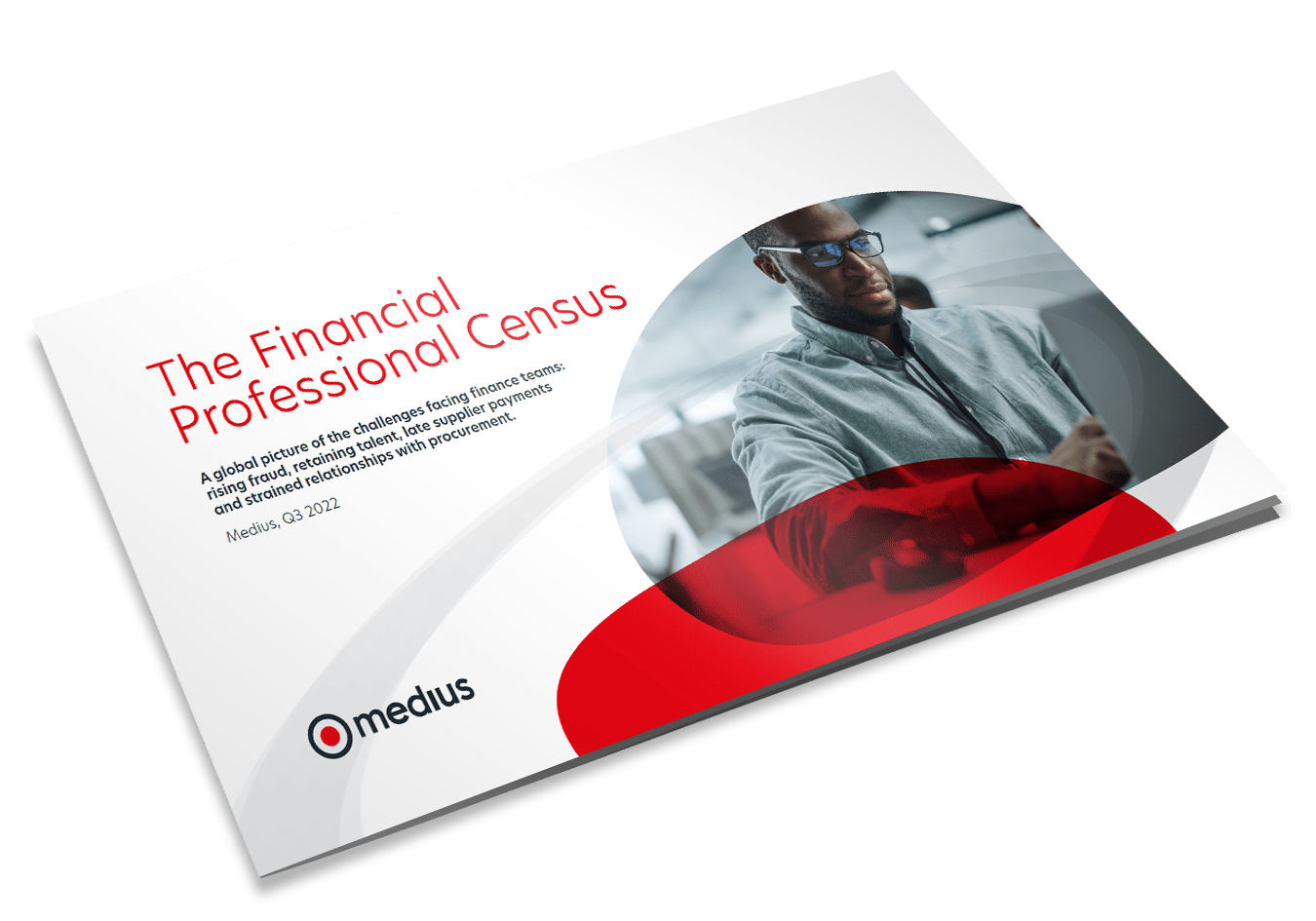
Learn about common hurdles facing financial professionals today, and how to overcome them. Get an in-depth look at the impact of fraud, late supplier payments, communication practices in Finance departments, and job satisfaction for Finance professionals.
Ardent Partners 2023 ePayables Technology Advisor
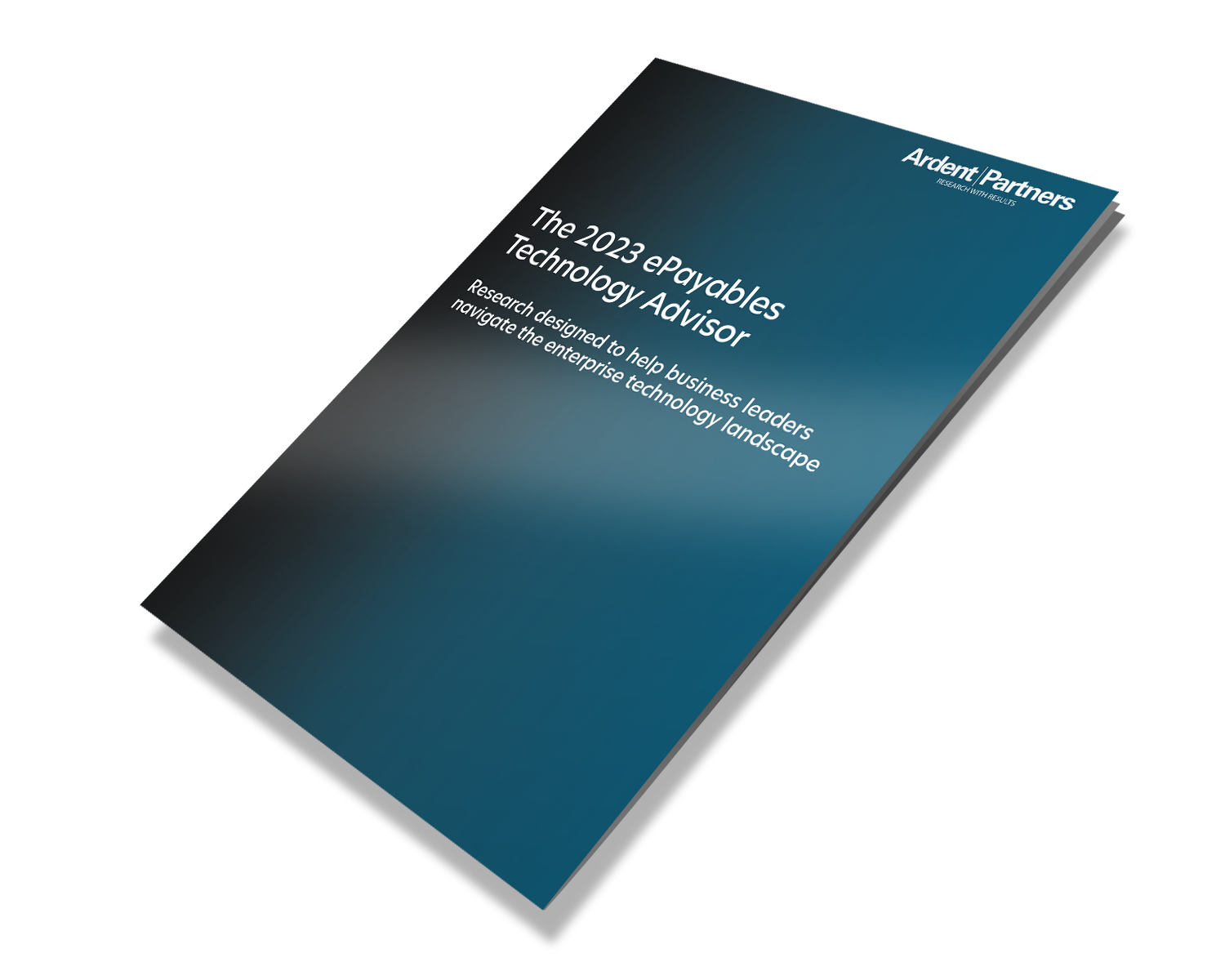
Navigating the market of AP vendors can be overwhelming. Download the 2023 Ardent Partners' ePayables Technology Advisor report, courtesy of Medius, to help make the right decision for your organization.
AP Automation Savings Calculator

Find out how much you could save with AI-driven Accounts Payable Automation. Start by answering a few simple questions about your current AP and Finance processes, then get a customized report of what you can expect when you trade manual work for modern, intelligent technology.
Explore our insights: Expert blogs on AP Automation
Dive deeper into the world of accounts payable automation with our curated selection of expert blogs. Each blog offers a unique perspective, shedding light on various aspects of AP automation. From practical tips to industry insights, our blogs are designed to keep you informed and ahead of the curve.
FAQs: Your questions about AP Automation answered
AP Automation refers to the use of technology to streamline and automate the accounts payable process, reducing manual effort and increasing efficiency. It involves converting invoices into digital format, automatically matching them to purchase orders, and processing payments, often integrated with existing financial systems.
Automating your accounts payable process can significantly reduce manual errors, speed up invoice processing, enhance data accuracy, and improve overall financial management efficiency. It allows for better cash flow visibility and frees up your finance team to focus on strategic tasks rather than repetitive, manual work.
AP Automation solutions typically integrate seamlessly with existing ERP systems, facilitating data synchronization and consistent financial record-keeping. This integration ensures that invoice data automatically updates in the ERP system, maintaining a single source of truth for financial data.
When selecting an AP Automation solution, consider factors such as ease of integration with existing systems, user-friendliness, scalability, data security features, customization options, and the level of customer support offered.
AP Automation ensures timely and accurate payments to vendors, enhancing trust and reliability. It also provides better communication and transparency, allowing for quicker resolution of disputes and a more collaborative relationship with suppliers.
Yes, cloud-based AP Automation solutions are typically secure, employing advanced encryption, regular security audits, compliance with data protection regulations, and backup systems to protect financial data.
The implementation time for an AP Automation system varies but typically ranges from a few weeks to several months, depending on the complexity of the system, the level of customization required, and the size of the organization.
Yes, AP Automation can significantly aid in regulatory compliance by ensuring accurate and timely financial records, maintaining a clear audit trail, and adhering to various financial standards and regulations.
AP Automation streamlines and automates many tasks that are manually performed in traditional AP processes, such as data entry and invoice matching. This leads to faster processing, reduced errors, improved data accuracy, and better financial oversight.
AP Automation provides real-time visibility into financial obligations and available funds, allowing for more effective cash flow management. It enables businesses to optimize their payment timings, negotiate better payment terms, and make informed financial decisions.
Modern AP Automation systems are equipped to handle transactions in multiple currencies and manage payments to international suppliers efficiently. They automatically account for currency conversions and comply with global financial regulations.
AP Automation solutions can generate a variety of reports, including accounts payable aging reports, cash flow analysis, vendor payment histories, expense reports, and compliance reports, providing valuable insights into financial operations.
